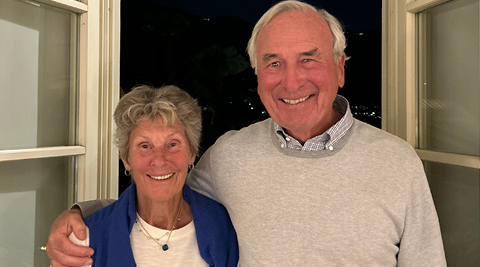For Hughes Family, All Eyes on Glaucoma Research

This story was published in the March 2024 issue of The Philanthropist, a newsletter for supporters and friends of Northwestern University Feinberg School of Medicine. Read past issues here.
For many, glaucoma is an alarming diagnosis associated with a risk of eventual blindness.
Glaucoma is a group of eye diseases that causes vision loss for which there is no cure. It is preventable and treatable through the lowering of eye pressure, but doctors do not yet have a way to recover the vision that has been lost due to the disease.
When Martin “Marty” Hughes was diagnosed with glaucoma by his longtime optometrist in 2006, he said, “I'm out of here.” He called Northwestern, where Angelo P. Tanna, MD, vice chair, professor, and director of the Glaucoma Service in the Department of Ophthalmology at Northwestern University Feinberg School of Medicine, assumed his care.
Dr. Tanna confirmed Mr. Hughes’s glaucoma diagnosis and started him on a treatment regimen to lower the pressure in his eyes. Eye drop medications helped, yet even with multiple medications, Mr. Hughes’s eye pressure did not drop enough to completely stop the deterioration of his vision in his right eye. Dr. Tanna recommended a surgery called trabeculectomy. At the time, Dr. Tanna was the principal investigator of a clinical trial studying a novel method for preventing excessive scar formation that can be a barrier to long-term success of the surgery.
The two had developed a rapport, and Mr. Hughes decided to participate in the clinical trial. The surgery was a success, and his vision stabilized. A few years later, he underwent the same surgery in his left eye. Now, 18 years after his original diagnosis, his eye pressures are well controlled, he does not use any eye drops, and he only needs to check in with Dr. Tanna a few times a year.
“My vision is like 20/25 without glasses. I don’t have to wear contacts anymore thanks to the surgeries,” Mr. Hughes said.
More than 3 million Americans have glaucoma, and as the population ages, that number is expected to rise to 4 million by 2030. Dr. Tanna is researching the efficacy and safety of glaucoma medications, novel methods to prevent the formation of excessive scar tissue after glaucoma surgery, and the assessment of visual function in glaucoma. His findings have been instrumental, affecting the evaluation and treatment of patients with glaucoma everywhere.
In 2023, Mr. Hughes and his wife, Julia, made generous donations in support of Dr. Tanna’s research, after attending a seminar. They were moved by the opportunity to support something that would potentially affect their children and grandchildren, he said. The Hughes had lost their 12-year-old son in a tragic bicycling accident and donated his eyes to The Chicago Lighthouse, an organization that helps the blind and visually impaired.
“We kind of had an affection for that type of thing,” Mr. Hughes said. “So as we sat through Angelo’s presentation, I said to Julia, you know, we should support this. We should support what he’s doing.”
The Hughes are members of the Lifetime Giving Society within The Founders Society, as well as the Northwestern University Leadership Circle. Their giving has made a significant impact on Dr. Tanna’s research in the Department of Ophthalmology.
“This remarkable connection, between the Hughes family’s generosity and a uniquely talented physician-scientist who consistently moves from his observations as a clinician and surgeon to ask and answer questions in both the laboratory and with clinical studies, has ultimately resulted in several critical discoveries,” said Nicholas J. Volpe, MD, chair of the department and the George W. and Edwina S. Tarry Professor.
 AI in Glaucoma
AI in Glaucoma
Dr. Tanna’s research uses AI-based strategies to identify patients who are at highest risk for vision loss due to glaucoma and has yielded critical discoveries in the lab to improve surgical treatments.
“This disease affects the quality of life for millions of Americans,” Dr. Tanna said. “Our goal is to uncover and refine the most effective strategies to treat glaucoma in its early and late stages.”
His team is developing new techniques and evaluating existing treatments to better understand their utility. One new treatment involves the use of a hydrogel polymer to prevent scarring after trabeculectomy—a surgery to lower eye pressure by creating a new pathway for fluid to exit the eye in patients with advanced or recalcitrant glaucoma.
He is also studying approaches to improve the outcomes of glaucoma drainage device surgery or tube shunt surgery. His team has studied the optimization of the adjunctive use of existing glaucoma medications after surgery.
Private philanthropic funding has supported two Research Intensive Scholarly Emphasis (RISE) students, Dr. Tanna’s research fellows, and biostatisticians who work in the Biostatistics Collaboration Center.
“The Hughes’ support has made it possible to explore many investigative pathways simultaneously, and this has proven to be very rewarding, with findings that directly impact how we care for patients today,” Dr. Tanna said. “I have come to know Marty and Julie well over the years, and I am so fortunate to have met such compassionate people who are so enthusiastic about improving eye care for all.”
Innovations in Ophthalmology
The Hughes family joins a rich legacy of philanthropic commitment to the Department of Ophthalmology as it distinguishes itself as a powerhouse for eye care and research.
Scientists within the department are transforming how physicians diagnose and treat glaucoma and many other afflictions of the eye, including age-related macular degeneration, diabetic retinopathy, ocular inflammation, corneal blindness, and optic nerve disorders. The department’s collective expertise and position within the broader University and Northwestern Medicine community have generated momentum toward the establishment of an institute dedicated to these endeavors.
Additionally, new technologies such as artificial intelligence (AI) have opened new avenues for exploration within the department. In January, Dr. Tanna and his colleagues published a paper in the Journal of Glaucoma on the use of deep learning to predict and detect concurrent visual field progression based on imaging of the macula. Manjot K. Gill, MD, professor of Ophthalmology and Medical Education, is collaborating with Sadiya S. Khan, MD, MSc, the Magerstadt Professor of Cardiovascular Epidemiology, to examine connections between the retina and the heart. Other recent studies show promise in using AI to detect Alzheimer’s disease, renal function, and autism.
Many of these advances would not be possible without philanthropy, which enables scientists to collaborate and investigate innovative ideas, access cutting-edge technologies in biomedicine and retinal imaging, and lead and participate in clinical trials. Such is the case for Dr. Tanna’s glaucoma research.
“Having the time, the team, and the access to resources to make these important discoveries would not be possible without the Hughes’ support,” Dr. Volpe said.
For more information about supporting the Department of Ophthalmology, please contact Jordan Sund at jordan.sund@northwestern.edu or 312-503-2706.